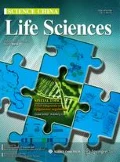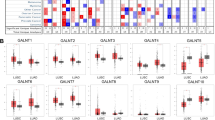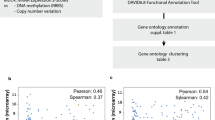Abstract
Esophagus squamous cell carcinoma (ESCC) is one of the most aggressive malignant tumors in the world. Our previous data demonstrates that oncoprotein MUC1 is related with metastasis and poor outcome of ESCC. However, alteration of MUC1 in ESCC remains unclear. Using ONCOMINE and COSMIC databases, we analyzed MUC1 gene copy numbers and gene mutations and found that MUC1 had high expression level but few gene mutations in ESCC. Further study of ESCC samples indicated that MUC1 O-glycosylation levels were higher in tumor tissues than that in para-carcinoma tissues in 10 of 14 pairs of ESCC samples. Moreover, we verified a potential link between MUC1 O-glycosylation and C1GALT1, which was further supported by IHC analysis on 38 ESCC and 19 para-carcinoma samples. More importantly, co-expression of MUC1 Oglycosylation and C1GALT1 presented positive correlations with both lymph node metastasis and survival time of ESCC patients. Our work collectively indicates that C1GALT1 is associated with O-glycosylated MUC1 in ESCC, not only suggesting a diagnostic significance of C1GALT1 and MUC1 O-glycosylation in ESCC, but also opening novel insights into targeting C1GALT1 and MUC1 O-glycosylation to suppress ESCC cells metastasis in patients.
Similar content being viewed by others
References
Aoyagi, K., Minashi, K., Igaki, H., Tachimori, Y., Nishimura, T., Hokamura, N., Ashida, A., Daiko, H., Ochiai, A., Muto, M., et al. (2011). Artificially induced epithelial-mesenchymal transition in surgical subjects: its implications in clinical and basic cancer research. PLoS ONE 6, e18196.
Apostolopoulos, V., Stojanovska, L., and Gargosky, S.E. (2015). MUC1 (CD227): a multi-tasked molecule. Cell Mol Life Sci 72, 4475–4500.
Arnold, M., Soerjomataram, I., Ferlay, J., and Forman, D. (2015). Global incidence of oesophageal cancer by histological subtype in 2012. Gut 64, 381–387.
Bennett, E.P., Mandel, U., Clausen, H., Gerken, T.A., Fritz, T.A., and Tabak, L.A. (2012). Control of mucin-type O-glycosylation: a classification of the polypeptide GalNAc-transferase gene family. Glycobiology 22, 736–756.
Chen, C.H., Hsiao, S.M., Chang, T.C., Wu, W.Y., and Lin, H.H. (2016). Clinical and urodynamic effects of baclofen in women with functional bladder outlet obstruction: preliminary report. J Obstet Gynaecol Res 42, 560–565.
Chen, C.H., Wang, S.W., Chen, C.W., Huang, M.R., Hung, J.S., Huang, H. C., Lin, H.H., Chen, R.J., Shyu, M.K., and Huang, M.C. (2013). MUFigure C20 overexpression predicts poor prognosis and enhances EGF-induced malignant phenotypes via activation of the EGFR-STAT3 pathway in endometrial cancer. Gynecol Oncol 128, 560–567.
Cheng, P.W., Radhakrishnan, P. (2011). Mucin O-glycan branching enzymes: structure, function, and gene regulation. Adv Exp Med Biol 705, 465–492.
Chou, C.H., Huang, M.J., Liao, Y.Y., Chen, C.H., and Huang, M.C. (2017). C1GALT1 seems to promote in vitro disease progression in ovarian cancer. Int J Gynecol Cancer 27, 863–871.
Fitzmaurice, C., Dicker, D., Pain, A., Hamavid, H., Moradi-Lakeh, M., MacIntyre, M.F., Allen, C., Hansen, G., Woodbrook, R., Wolfe, C., et al. (2015). The global burden of cancer 2013. JAMA Oncol 1, 505.
Hattrup, C.L., and Gendler, S.J. (2008). Structure and function of the cell surface (tethered) mucins. Annu Rev Physiol 70, 431–457.
Hung, J.S., Huang, J., Lin, Y.C., Huang, M.J., Lee, P.H., Lai, H.S., Liang, J. T., and Huang, M.C. (2014). C1GALT1 overexpression promotes the invasive behavior of colon cancer cells through modifying O-glycosylation of FGFR2. Oncotarget 5, 2096–2106.
Ju, T., Brewer, K., D’Souza, A., Cummings, R.D., and Canfield, W.M. (2002). Cloning and expression of human core 1 β1,3-galactosyltransferase. J Biol Chem 277, 178–186.
Kufe, D.W. (2009). Mucins in cancer: function, prognosis and therapy. Nat Rev Cancer 9, 874–885.
Luo, H., Guo, W., Wang, F., You, Y., Wang, J., Chen, X., Wang, J., Wang, Y., Du, Y., Chen, X., et al. (2015). miR-1291 targets mucin 1 inhibiting cell proliferation and invasion to promote cell apoptosis in esophageal squamous cell carcinoma. Oncol Rep 34, 2665–2673.
Müller, S., Alving, K., Peter-Katalinic, J., Zachara, N., Gooley, A.A., and Hanisch, F.G. (1999). High density O-glycosylation on tandem repeat peptide from secretory MUC1 of T47D breast cancer cells. J Biol Chem 274, 18165–18172.
McDermott, K.M., Crocker, P.R., Harris, A., Burdick, M.D., Hinoda, Y., Hayashi, T., Imai, K., and Hollingsworth, M.A. (2001). Overexpression of MUC1 reconfigures the binding properties of tumor cells. Int J Cancer 94, 783–791.
Peery, A.F., Crockett, S.D., Barritt, A.S., Dellon, E.S., Eluri, S., Gangarosa, L.M., Jensen, E.T., Lund, J.L., Pasricha, S., Runge, T., et al. (2015). Burden of gastrointestinal, liver, and pancreatic diseases in the United States. Gastroenterology 149, 1731–1741.e3.
Pinho, S.S., and Reis, C.A. (2015). Glycosylation in cancer: mechanisms and clinical implications. Nat Rev Cancer 15, 540–555.
Shi, M., Chen, D., Yang, D., and Liu, X.Y. (2015). CCL21-CCR7 promotes the lymph node metastasis of esophageal squamous cell carcinoma by up-regulating MUC1. J Exp Clin Cancer Res 34, 149.
Sohda, M., and Kuwano, H. (2017). Current status and future prospects for esophageal cancer treatment. Ann Thorac Cardiovasc Surg 23, 1–11.
Su, H., Hu, N., Yang, H.H., Wang, C., Takikita, M., Wang, Q.H., Giffen, C., Clifford, R., Hewitt, S.M., Shou, J.Z., et al. (2011). Global gene expression profiling and validation in esophageal squamous cell carcinoma and its association with clinical phenotypes. Clin Cancer Res 17, 2955–2966.
Taylor-Papadimitriou, J., Burchell, J., Miles, D.W., and Dalziel, M. (1999). Muc1 and cancer. BioChim Biophysica Acta (BBA)-Mol Basis Dis 1455, 301–313.
Tian, E., and Ten Hagen, K.G. (2009). Recent insights into the biological roles of mucin-type O-glycosylation. Glycoconj J 26, 325–334.
Wu, Y.M., Liu, C.H., Huang, M.J., Lai, H.S., Lee, P.H., Hu, R.H., and Huang, M.C. (2013). C1GALT1 enhances proliferation of hepatocellular carcinoma cells via modulating MET glycosylation and dimerization. Cancer Res 73, 5580–5590.
Xu, H.L., Zhao, X., Zhang, K.M., Tang, W., and Kokudo, N. (2014). Inhibition of KL-6/MUC1 glycosylation limits aggressive progression of pancreatic cancer. World J Gastroenterol 20, 12171.
Ye, Q., Yan, Z., Liao, X., Li, Y., Yang, J., Sun, J., Kawano, T., Wang, X., Cao, Z., Wang, Z., et al. (2011). MUC1 induces metastasis in esophageal squamous cell carcinoma by upregulating matrix metalloproteinase 13. Lab Invest 91, 778–787.
You, F., Jiang, L., Zhang, B., Lu, Q., Zhou, Q., Liao, X., Wu, H., Du, K., Zhu, Y., Meng, H., et al. (2016). Phase 1 clinical trial demonstrated that MUC1 positive metastatic seminal vesicle cancer can be effectively eradicated by modified anti-MUC1 chimeric antigen receptor transduced T cells. Sci China Life Sci 59, 386–397.
Acknowledgements
This work was supported by the National Natural Science Foundation of China (81472461) to Lei Huang.
Author information
Authors and Affiliations
Corresponding authors
Rights and permissions
About this article
Cite this article
Wang, Y., Liao, X., Ye, Q. et al. Clinic implication of MUC1 O-glycosylation and C1GALT1 in esophagus squamous cell carcinoma. Sci. China Life Sci. 61, 1389–1395 (2018). https://doi.org/10.1007/s11427-017-9345-7
Received:
Accepted:
Published:
Issue Date:
DOI: https://doi.org/10.1007/s11427-017-9345-7




